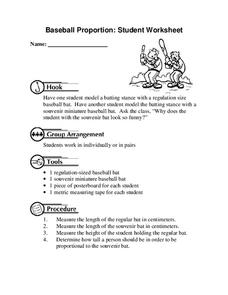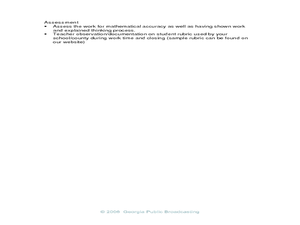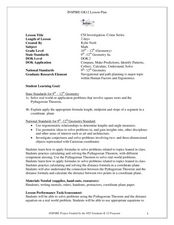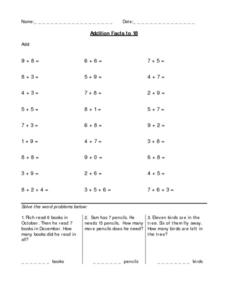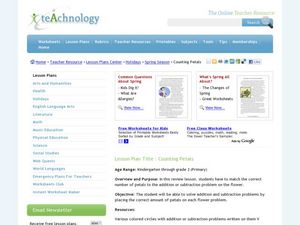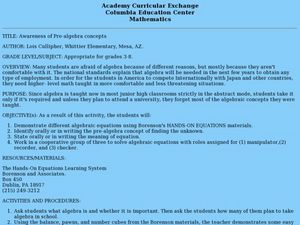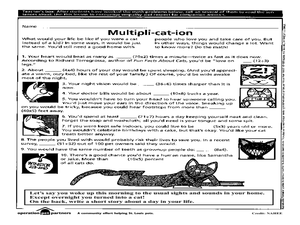EngageNY
Comparison Shopping—Unit Price and Related Measurement Conversions II
Which rate is greater and by how much? Pupils continue to compare rates to solve problems in the 20th portion of a 29-part series. Rates are presented in a variety of representations either using the same representation or different...
West Contra Costa Unified School District
Lowest Common Multiple through the Grades
The LCM will be your new BFF. Learners review least common multiple and least common denominator applications, mostly on fractions, from middle school. Scholars then see how the LCM can be applied to various types of problems from...
Curated OER
Baseball Proportion: Student Worksheet
In this mathematics worksheet, learners model a batting stance with a regulation size baseball bat. Then they model the batting stance with a souvenir miniature baseball bat. Students measure the length of each bat in centimeters and use...
Curated OER
Number Addition Race
Practice basic addition facts and measuring skills. For this addition and measurement lesson, students are provided with drywall tape and work in groups of four at a long table. Partners take turns generating addends and marking the...
Curated OER
The Distance and Midpoint Formula
In this college level mathematics worksheet, students solve use the Pythagorean Theorem to find the missing side of a right triangle and explore the connection between the Pythagorean Theorem and the distance formula. Students also...
Mathematics Assessment Project
Matching Situations, Graphs and Linear Equations
What do guitars, candles, and helicopters have in common? They're all in this resource. Learners complete an assessment task to determine the amount of profit made in a guitar class based on given information regarding variable...
Curated OER
Exercise Set 2.7: Functions and Graphs
In this functions worksheet, students solve 40 short answer problems. Students determine if a graph represents a function. Students find the domain of absolute value and square root functions.
Futures Channel
Algebra Magic
Abracadabra! Letters can be used in math to represent numbers with the operations of addition, subtraction, multiplication, and division to solve problems! Math magicians will participate in an activity that uses a calculator and a bag...
Curated OER
Polygon Division Models
Learners use polygons to explore division. They use pattern blocks to represent whole numbers and fractions. They discuss divisors, factors, dividend and products. In groups, students present models and solve problems. They justify their...
Curated OER
Three Squirrels and a Pile of Nuts
Students solve story problems using a spreadsheet in combination with various problem-solving strategies. Working in teams of three, students create attempt to solve a story problem using three different methods; using manipulative,...
Curated OER
Differentiating with Daily Math Puzzlers
Young scholars practice word problems based on their own needs and skill levels. In this math word problems lesson, students practice completing one word problem each day until they can move on to the next level.
Curated OER
Sentence Match
Fifth graders explore the concept of equivalency. In this math lesson, 5th graders write their own word problems and pair them to appropriate algebraic number sentences.
Curated OER
Marta Pricing Options
Third graders determine whether buying a "package deal" is really the best deal. For this consumer math lesson, 3rd graders watch a video clip and use math skills to solve a word problem determining which "package deal" is the best deal.
Curated OER
CSI Investigation
Young scholars solve real life situation using the Pythagorean Theorem. In this geometry lesson, students calculate the length, midpoint and slope of segments. They solve word problems using properties of square roots.
Curated OER
Math Jeopardy
Young scholars, in teams, play Math Jeopardy against each other as a way to reinforce their skills.
Curated OER
The Three Cold Kittens
Students solve a math word problem involving repeated addition. They identify the important information in the problem, brainstorm ways to solve the problem, and solve the problem and discuss the solution as a class.
Curated OER
Addition Facts to 18
In this simple addition worksheet, 3rd graders solve 14 problems adding 2 one-digit numbers. Students also solve 3 problems adding 3 one-digit numbers. Finally, students solve 3 word problems involving simple addition.
Curated OER
Gift Wrapping
Sixth graders use the example of a gift wrapping service found in the mall in order to create a problem situation that can be solved mathematically. They convert the word problem into algebraic expressions to be solved.
Curated OER
When Am I Ever Going to Use this?
Young scholars solve problems using equations and properties of integers. In this algebra lesson, students solve problems using ratio and proportion and graph their answers on a coordinate plane. They solve word problems using geometry.
Curated OER
Counting Petals
Students solve addition and subtraction problems. In this problem solving lesson, students solve math problems written on flowers. Using petals as a counting aid, students demonstrate the answer by attaching the correct number of petals...
Curated OER
Awareness of Pre-Algebra Concepts
Students demonstrate how to solve various algebraic equations. In this pre-algebra lesson, students work in teams and use Borenson's Hands-On Equations materials to solve algebraic equations.
Curated OER
Estimating With Fractions
Seventh graders, exploring methods to estimate fractions, take notes on estimating fractions, 7th graders write letters to explain the process of estimating fractions and mixed numbers to someone who does not know the concept. Students...
Curated OER
Pet overpopulation-Dogs and Cats Can't Add or Subtract, But They Sure Can Multiply
Students explore pet overpopulation. In this character development instructional activity, students solve math story problems to determine how many kittens can be produced by one unspayed cat. Students discuss the consequences of pet...
Curated OER
Ag In The Outfield
Young scholars explore baseball. This is a cross-curricular plan that includes math, history, and agriculture. Pupils use their five senses to observe the materials a baseball is made from and identify the agricultural products used. In...




